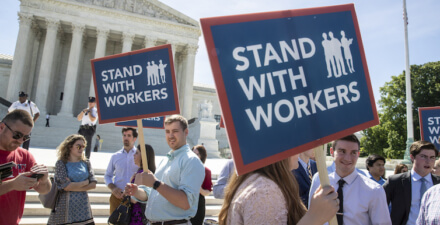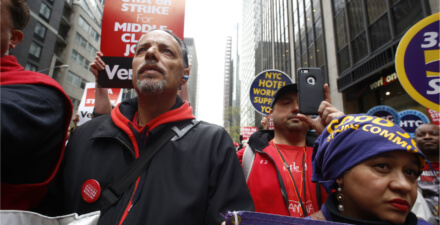Equitable Growth CEO’s written testimony at California Future of Work Commission
Heather Boushey
California Future of Work Commission
September 10, 2019
On Sept. 10, 2019, Heather Boushey, president and CEO of the Washington Center for Equitable Growth, participated in a discussion hosted by California Gov. Gavin Newsom as part of his Future of Work Commission. Below are her written remarks.
We are currently experiencing the longest economic recovery in U.S. history, but the gains from that economic growth—the money in peoples’ pockets—aren’t being shared. That hurts families and the long-term trajectory of our economy.
The top-line economic markers signal to policymakers that our economy is growing—indicators such as a historically low unemployment rate and annual Gross Domestic Product growth of around 2 percent—and that real wage growth has begun to pick up in recent months. But it’s also true that wages are not growing commensurate with a tight labor market and that the fruits of our economic growth, in terms of both income and wealth, are diverging sharply.
The Federal Reserve Board’s new Distributional Financial Accounts and the latest research by University of California, Berkeley economists Emmanuel Saez and Gabriel Zucman document that income inequality is historically high, and wealth inequality is outpacing it.1
Inequality hurts economic growth and mobility. Growth has slowed since 1980, and average people no longer share in the growth we do have. The bottom 50 percent of the population has the same inflation-adjusted pretax income that they did in 1980, and lower absolute mobility means that people born in 1980 now have only a 50 percent chance of surpassing their parents’ income.2
Inequality constricts growth by:
- Obstructing the supply of people and ideas into our economy and limiting opportunity for those not already at the top, which slows productivity growth over time
- Subverting the institutions that manage the market, making our political system ineffective and our labor markets dysfunctional
- Distorting demand through its effects on consumption and investment, which both drags down and destabilizes short- and long-term growth in economic output
Emblematic of these impediments to more broad-based economic growth today is the monopoly power problem—one that exacerbates inequality, contributes to wage stagnation, limits entrepreneurship, increases the cost of living, and stifles innovation. This affects the U.S. labor market in three interconnected ways:
- Industry concentration and declining economic dynamism reduces wages by limiting workers’ employment options and opportunities for advancement, and allows firms to use their increasing power to squeeze worker compensation in favor of greater profits.
- Workplace fissuring, through the rise of independent contractors, franchisors, and contingent hiring, prevents workers from accessing career ladders, matching into the jobs they are best suited for, and gaining sufficient bargaining power to unlock wage increases.3
- Persistent historical disparities such as wage discrimination and social norms reinforce occupational segregation into jobs that don’t pay well enough and offer little room for advancement.
Yet policymaking over the past several decades has been moving in the wrong direction. Specifically:
- Antitrust law now allows firms to accrue and abuse monopoly power, not just over consumers but also in many cases over workers.4
- Successive rounds of tax cuts, including the Tax Cuts and Jobs Act of 2017 and several tax cuts under the George W. Bush administration, have lowered the progressivity of the tax code and greatly decreased taxes on wealth, capital, inheritances, and corporate profits.
- Outdated labor law provides insufficient protection of workers and has facilitated the long decline of unions, traditionally the most vocal and ardent advocates for the middle class.
We have an opportunity right now to take a step back to look at the scale and scope of the problems and develop real solutions. We need an economic policy agenda that supports families and builds a strong economy. Policies must fit the scale and scope of today’s problems.
There are fast-growing jobs—in the provision of childcare and eldercare, in healthcare, and education, for example—that face a lower risk of worker displacement by technology. Yet workers in many of these jobs have little to no bargaining power and access to few benefits. In 2018, the median hourly wage for personal care workers in California was $11.80—significantly lower than the state median wage of $20.40. About 6 in 10 childcare workers in California earn so little that they qualify for public assistance.5
The effect automation and artificial intelligence will have on workers are important challenges. But the way we as a society respond to them will be determined by the power arrangements in place in the labor market.
Workers’ voices need to be heard to balance the potential negative consequences of automation and AI. Worker input can shape the implementation of new technology, so that its consequences are more equitable for workplace dynamics and production processes, and help workers share in the gains of growth.
And fundamental to addressing abusive labor practices associated with the problem of fissuring in the workplace are the continual goals of the U.S. labor movement. These include higher minimum wages and union representation in addition to enforcement and expansion of workplace protections such as schedule stability protections, paid family and medical leave, and paid sick leave.6
Policymakers should also design and fully embrace policies to eliminate discrimination in the labor market. Policymakers can start by measuring the structural problems—collecting firm-specific employment and pay data by gender, race, and ethnicity.
It is vitally important to think about the “future of work,” but we can and must prepare for the jobs of now.
End Notes
1. Raksha Kopparam, “The Federal Reserve’s New Distributional Financial Accounts Provide Telling Data on Growing U.S. Wealth and Income Inequality,” Value Added blog, August 22, 2019, available at https://equitablegrowth.org/the-federal-reserves-new-distributional-financial-accounts-provide-telling-data-on-growing-u-s-wealth-and-income-inequality/.
2. Thomas Piketty, Emmanuel Saez, and Gabriel Zucman, “Distributional National Accounts: Methods and Estimates for the United States,” The Quarterly Journal of Economics 133 (2) (2018): 553–609, available at https://doi.org/10.1093/qje/qjx043; Raj Chetty and others, “The Fading American Dream: Trends in Absolute Income Mobility since 1940,” Science 356 (6336) (2017): 398–406, available at https://doi.org/10.1126/science.aal4617.
3. Corey Husak, “How U.S. Companies Harm Workers by Making Them Independent Contractors,” Value Added blog, July 31, 2019, available at https://equitablegrowth.org/how-u-s-companies-harm-workers-by-making-them-independent-contractors/; Brian Callaci, “New Research Shows the Franchise Business Model Harms Workers and Franchisees, with the Problem Rooted in Current Antitrust Law,” Value Added blog, December 13, 2018, available at https://equitablegrowth.org/new-research-shows-the-franchise-business-model-in-the-united-states-harms-workers-and-franchisees/; Washington Center for Equitable Growth, “Evolving Worker and Management Attitudes toward Labor Organizations: The Equitable Growth Context,” Value Added blog, April 3, 2019, available at https://equitablegrowth.org/evolving-worker-and-management-attitudes-toward-labor-organizations-the-equitable-growth-context/.
4. Michael Kades, “Anticompetitive Mergers: They Are Not Just a Threat to U.S. Consumers Anymore,” Value Added blog, June 20, 2018, available at https://equitablegrowth.org/anticompetitive-mergers-they-are-not-just-a-threat-to-u-s-consumers-anymore/.
5. Deborah Stipek, “Early Childhood Education in California” (Stanford University and Policy Analysis for California Education, 2018), available at https://gettingdowntofacts.com/sites/default/files/2018-09/GDTFII_Brief_EarlyChildhood.pdf.
6. Alix Gould-Werth, “New Research Shows Links between the Quality of U.S. Retail Workers’ Schedules and Their Well-Being,” Value Added blog, February 8, 2019, available at https://equitablegrowth.org/new-research-shows-links-between-the-quality-of-u-s-retail-workers-schedules-and-their-well-being/.






